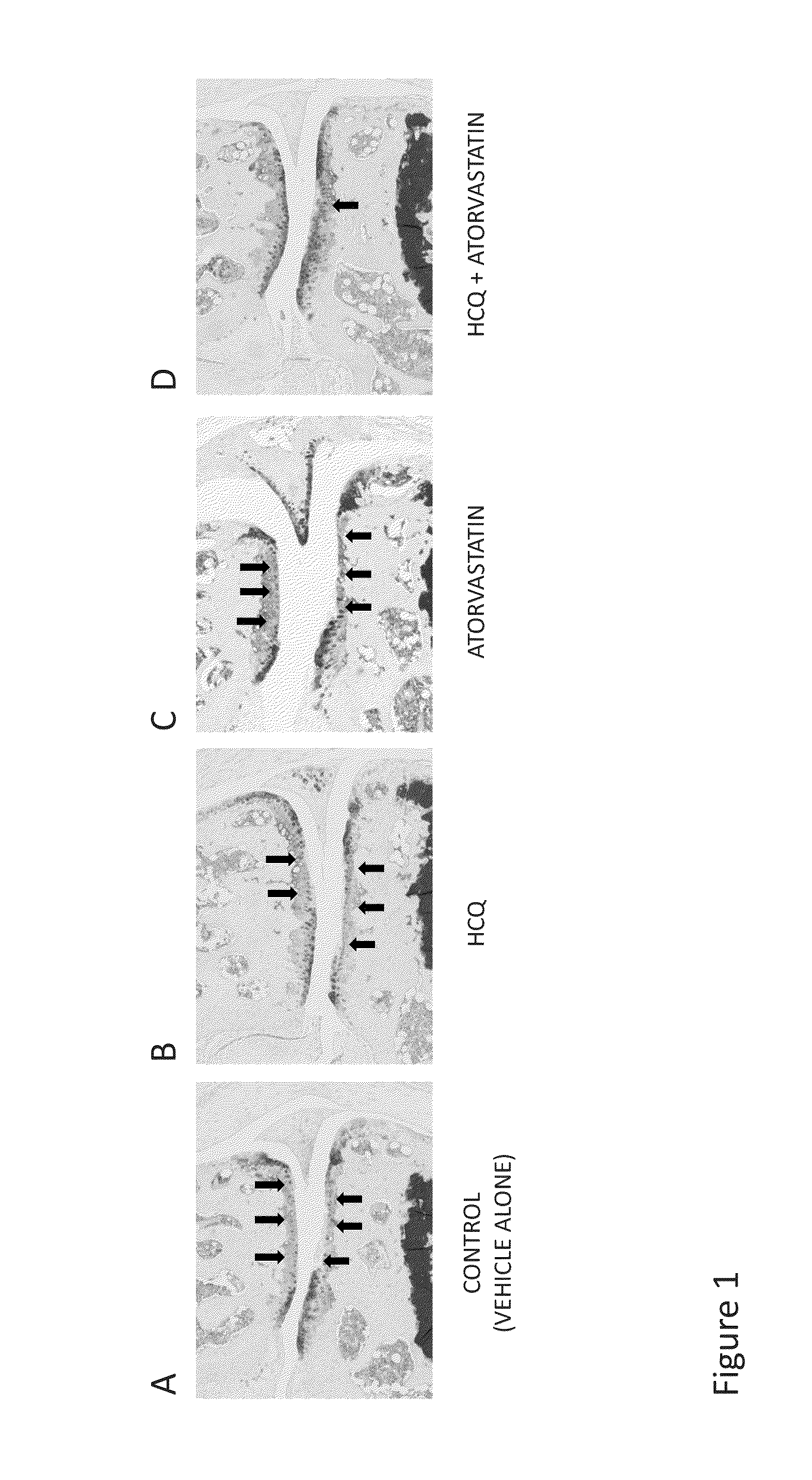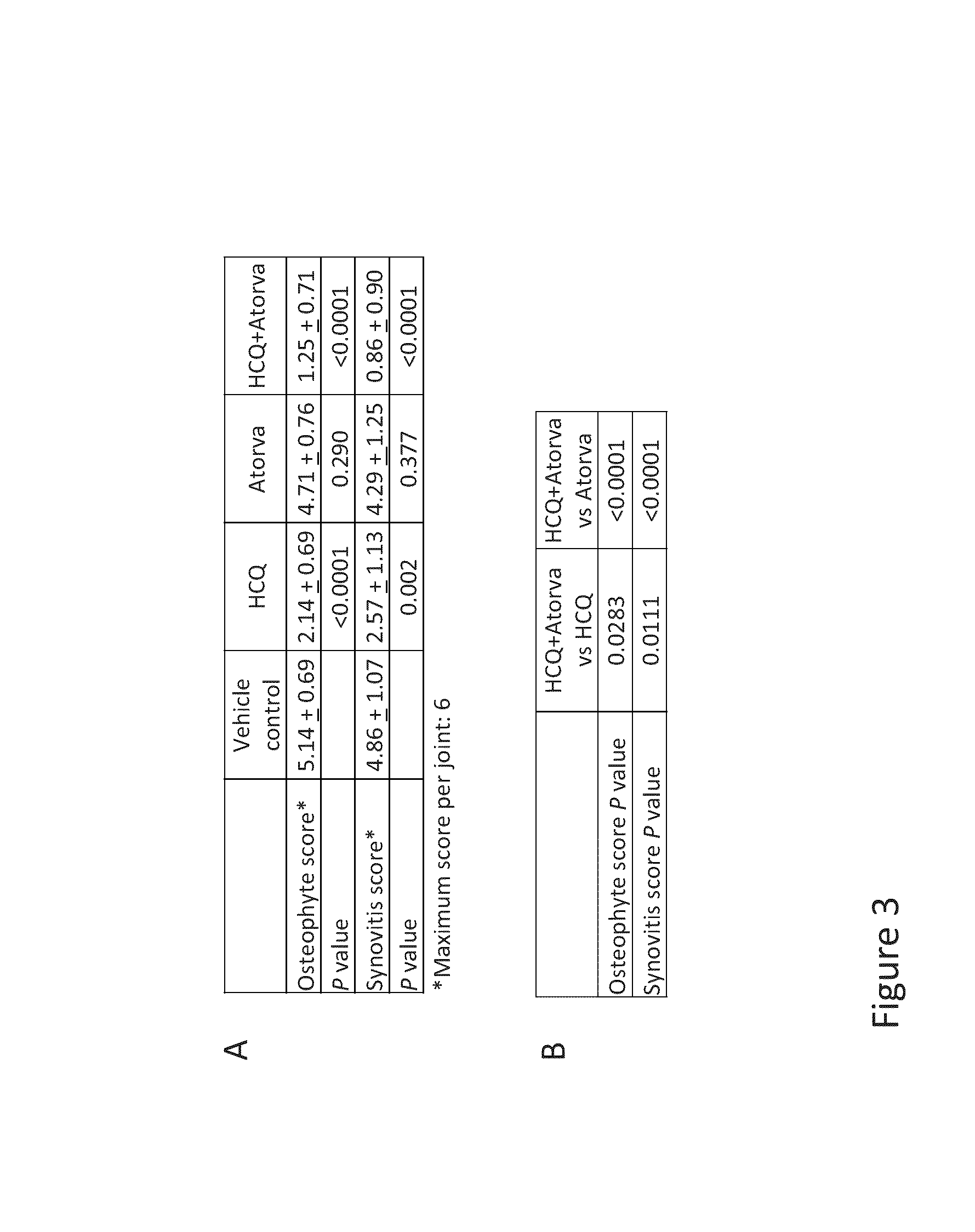Treatment of diseases associated with inflammation
a technology of inflammation and disease, applied in the field of inflammation prevention and treatment, can solve the problems of ocular toxicity, eye toxicity, mild nausea and occasional stomach cramps, etc., and achieve the effect of reducing or preventing disease development, preventing progression, or preventing disease progression
- Summary
- Abstract
- Description
- Claims
- Application Information
AI Technical Summary
Benefits of technology
Problems solved by technology
Method used
Image
Examples
example 1
Treatment with the Combination of HCQ and Atorvastatin Inhibited the Development of and Reduced the Severity of Mouse Osteoarthritis (OA)
[0288]Mouse Models of OA.
[0289]C57BL6 (B6) mice (n=7-10 per group) were surgically induced to develop OA by medial meniscectomy (MM) or destabilization of the medial meniscus (DMM). Experiments were performed under protocols approved by the Stanford University Committee of Animal Research and in accordance with NIH guidelines. Mouse OA was generated either by DMM (Glasson, S., S., et al., Osteoarthritis Cartilage, 15: 1061-1069 (2007)) or by MM (Kamekura, S., et al., Osteoarthritis Cartilage, 13: 632-641 (2005)). One week and two weeks following surgical induction of the MM or DMM model, the articular cartilage is intact and there is no overt evidence of OA—at this time point the mice walk and run normally and are asymptomatic or can exhibit mild joint symptoms, but owing to the surgical procedure the mice have pre-clinical or early-stage OA and go...
example 2
The Combination of Hydroxychloroquine and Atorvastatin Reduced Synovitis and Improved the Pain and Functional Scores in Humans with Medial-Compartment Knee OA in a 16-Week, Open-Label, Pilot Clinical Trial
[0296]Nearly 27 million people in the U.S. have some form of OA, a number that has increased from 21 million in 1990. Knee OA is prevalent in 16% of all adults 45 years and older. In Canada, OA affects 10% of the entire population. In 2005, the cost of loss of productivity by U.S. workers as a result of OA exceeded $70 billion. Medical therapies used to treat OA include NSAIDs, acetaminophen, intra-articular corticosteroids, intra-articular hyaluronic acid formulations, narcotics, and physical therapy. While all of these treatments may alleviate the symptoms of OA, there are no medical therapies currently available that prevent the progression of cartilage loss or reverse the disease process. In patients with more severe knee OA, total joint replacement is an option. The incidence ...
example 3
Use of Combination Therapy with Hydroxychloroquine and Atorvastatin to Inhibit Development of and to Reduce the Severity of Osteoarthritis (OA)
[0314]Humans are screened for evidence of early-stage OA or pre-clinical OA or being at increased risk of developing OA. Many factors can increase an individual's risk of developing OA, for example, joint injury, joint surgery, degenerative meniscal tears, degeneration of articular cartilage, anterior cruciate ligament tears, defects in collagen or other matrix proteins, genetic predisposition, etc. Humans with pre-clinical or early-stage OA are asymptomatic, or have mild or intermittent joint pain, and can be treated with the combination of hydroxychloroquine and atorvastatin to prevent the development of the symptoms and signs of clinical OA, as well as to prevent the progression of pre-clinical or early-stage OA. Further, humans at risk for OA, with pre-clinical OA or with early-stage OA can be tested for the presence of inflammation in th...
PUM
| Property | Measurement | Unit |
|---|---|---|
| weight | aaaaa | aaaaa |
| body weight | aaaaa | aaaaa |
| time | aaaaa | aaaaa |
Abstract
Description
Claims
Application Information
 Login to View More
Login to View More - R&D
- Intellectual Property
- Life Sciences
- Materials
- Tech Scout
- Unparalleled Data Quality
- Higher Quality Content
- 60% Fewer Hallucinations
Browse by: Latest US Patents, China's latest patents, Technical Efficacy Thesaurus, Application Domain, Technology Topic, Popular Technical Reports.
© 2025 PatSnap. All rights reserved.Legal|Privacy policy|Modern Slavery Act Transparency Statement|Sitemap|About US| Contact US: help@patsnap.com



